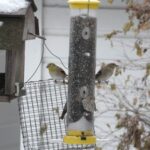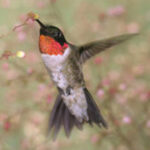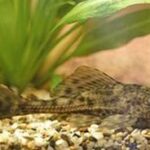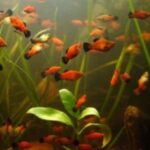The popularity surrounding the plecostomus is not what you would characterize along the same lines as the Beatles and their British invasion back in the 1960’s. The fact that these fish are benthic area bottom feeders that normally do not exhibit dramatic color variations and lack strong mobility characteristics when compared to their pelagic fish counterparts affords these fish a less than notorious importance in many aquarists eyes. This scenario really couldn’t be any further from the truth as the impact that a plecostomus portrays, whether it be from a biological stand point or their diverse, unique behavioral characteristics that are an essential part of the benthic areas of any aquarium. The Blue-Eyed Plecostomus, with its mystical grayish appearance and gleaming blue eyes represents yet another ideal, bottom dwelling inhabitant so beautifully suited for tropical fish tanks.
The blue-eyed pleco or panaque suttoni, is a very hardy bottom dwelling fish that tends to be rather shy and mainly visible at night after the lights go off. These animals can be trained to come out during the day in search of food however, by feeding algae pellets/discs. Being that these fish are primarily algae eaters, the addition of live plants and driftwood will only help to recreate their environment in the wild, and afford the pleco of ideal locations to search for food to graze upon. Boiled zucchini and various forms of lettuce such as romaine and spinach will also be eagerly accepted and affords the fish of a nutrient rich food alternative. The blue-eye pleco will also perform a yeoman’s job in maintaining an algae free aquarium by removing algae and uneaten food stuff that makes its way to the confines of the benthic areas of an aquarium, helping to improve water conditions and the tanks overall ambiance and eye appeal.
A slightly acidic water with a hardness(dGH) of around 15 is ideal for the health of these beautiful fish. A stable water temperature between 72-77 degrees is also desirable in your efforts to maintain a blue-eyed pleco for any extended period of time. Powerful filtration and the addition of carbon will only further increase the odds of not only blue-eyed plecos, but all of the inhabitants in an aquarium, by removing various wastes that, if not effectively and efficiently removed, will lead to less than desirable results.
Blue-eyes have a short, blunt facial region with spoon shaped teeth that are wider at the tip than at the base of their teeth. They come complete with a sort of armored plate look due to the longitudinal rows of scutes that cover their body. The body of all panaque plecos is plump with their head being larger and shorter than that of other plecostomus species.
For the most part the blue-eyed pleco will coexist with most other tank mates. On occasional scrabble with similar species of pleco may be evident but this doesn’t place any real harm on either party involved in the aggressive behavior.
From the novice to the advanced aquarist and all experience levels in between, the blue-eyed pleco can offer a unique addition to a freshwater aquarium. If you have a freshwater aquarium of 30 gallons or larger and the need, which every aquarist undoubtedly does, a bottom dwelling fish to help keep algae in check and comb the substrate for food before it begins to decay leading to other problems. The price of one of these or similar panaque species such as the Royal Blue and phantom plecos does command a higher price than that of the more common encountered plecos, but the trade off, I feel, Is worth its weight in gold.
With careful inspection of your possible purchase for any evidence of lie sons, damaged fins and/or mouth areas, protruding growths on the body and redness or swelling of the tissue around the eyes and mouth especially, you can reduce the chances of these beautiful plecos dying long before they should have.




